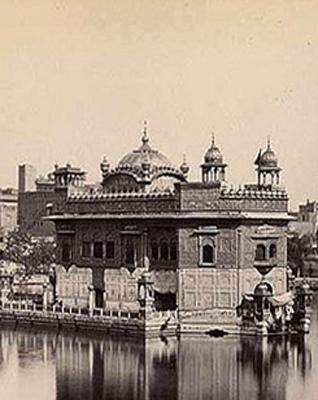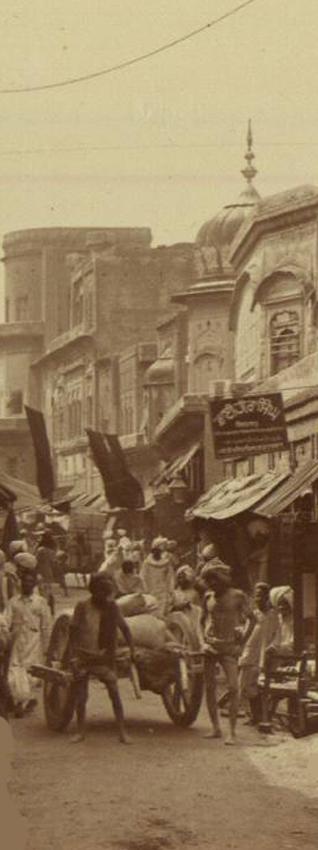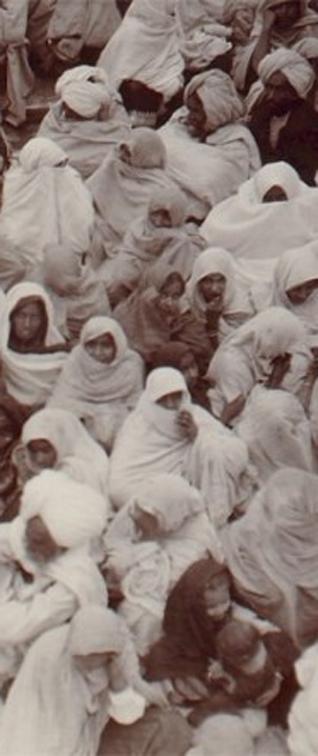Partition
Ambarsar:
The Amritsar of Yore - Guru ki Nagri
by ZAFAR ULLAH POSHNI
I was born in 1926 in Amritsar, Punjab - Ambarsar in Punjabi. But my father, who was an engineer in the M.E.S., was posted in Bareilly ("U.P." - then the United Provinces, now Uttar Pradesh), and I spent the first nine years of my life there. In 1935, my father, who had risen from the ranks to be given the title of Khan Bahadur by the British for meritorious services, retired with a handsome pension.
He immediately shifed to his home town, Amritsar.
Dad was an affluent man and purchased a large sized bungalow on Maqbool Road in the Civil Lines area of Amritsar.
I was proud of the fact that we had a car - at that time I estimate there were probably no more than 50 cars in the city. Many rich people preferred to maintain horse-driven vehicles like a phaeton, buggy or raeesi tonga rather than a car, even though the cost of feeding a horse would have been higher than the cost of petrol, which was dirt cheap then. Actually, everything was dirt cheap, but then salaries were pretty low too.
We used to pay five rupees a month to a man servant and three to a maid, plus food, of course. My father was really rich, even his pension was about Rs. 350 a month, but other relatives in our clan were just so-so, and some were very poor.
I remember one cousin of my Dad’s who was considered to be doing relatively well. He was a clerk in a government office with a salary of Rs. 35 per month and his lifestyle seemed devoid of any discomfort. If you were earning between Rs. 30 and Rs. 50 per month in those days you were considered to be in the comfort zone.
I, a privileged child, was living in this big house in the Civil Lines, which had lights and ceiling fans in all the rooms (of course nobody had even heard of air-conditioning at the time). But when I used to go downtown to the congested areas to play with my various cousins I used to feel very depressed to see that in most of their houses there was no electricity at all and they were using lanterns or oil wick lamps (diya) at night.
During the long summer days the sun would heat up the rooms so much in these homes - usually double (or at the most triple) storeyed houses - that the extended families living in them had to sleep on the open roof tops (kotha). I can now well imagine the problems of privacy this must have entailed, especially for young married couples, but at that time I was just a kid and did not comprehend this aspect of the sleeping arrangements of multiple families living in the same house without electricity!
At a rough guess I would say that nearly three-fourths of the city folk were living without electric lights or fans in Amritsar at that time.
But Amritsar was cosmopolitan.
Sikhs, Muslims, Hindus, Christians, even some Parsees, lived in this city. I recollect that one of the most attractive bungalows on Mall Road belonged to a certain Parsee gentleman, Dr Maneckshaw. His daughter Celia used to teach English in the school where I studied. Dr. Maneckshaw’s son, Sam Maneckshaw, had joined the Army. Many decades later he planned the conquest of East Pakistan (1971) and was rewarded by the Indian government with a promotion to the rank of Field Marshal, the first and the only Field Marshal to command the Indian Army since Independence.
While in the city itself, Muslims were in a majority, in the Amritsar district as a whole they were a minority. The reason being that most of the villages in the district were populated by Sikhs and Hindus, though there were Muslims also living in these villages and there were even some villages which were overwhelmingly Muslim. But at the time of partition the Boundary Commission decided on the basis of the district as a whole, and so Amritsar was allocated to India because the non-Muslims were slightly greater in numbers.
By and large the various communities lived quite peacefully, even though there were Muslim areas and non-Muslim areas of residence, and there was the Khalsa College, the Muslim Anglo Oriental (MAO) College (where Professor M.D. Taseer and Faiz Ahmed Faiz taught), and also a Hindu Sabha College, in Amritsar. During inter-college hockey and cricket matches tension would sometimes arise when the students cheered their respective teams and sometimes there were minor clashes, usually fisticuffs and at the most hockey sticks being used as weapons.
Unlike today’s bloody happenings, there were never any fatalities, and before the vicious partition riots broke out, I seldom heard of any clashes where firearms or even knives and swords were used. Prior to 1947, the British administration was effective and firm, impartial as between the ‘natives’, and there was definitely rule of law, something which has been almost totally annihilated by our ruling class over the years. Compared to the present day, the frequency of crime was far lower.
My younger sister used to ride a bicycle alone to her school and there was never any incident or mishap to discourage her.
Except for a very, very few emancipated families like ours where the girls did not observe purdah, almost all Muslim females in Amritsar wore the burqa - either the white shuttlecock burqa or the two piece ‘fashionable’ black burqa. The non-Muslim women were a bit more open, but even among them some would cover their faces with their head covering (ghunghat) when venturing into the street. There were very few cases of molesting, harassment or rape compared to our present horrendous and disgraceful state of affairs.
Of course, except for a few Anglo Indian and Christian nurses, there were hardly any working women in those days. Almost every woman was a housewife and cooking and serving the males was her primary duty. These ladies certainly believed that the way to a man’s heart was through his stomach!
In my community (Kashmiris) tea drinking was common, but in other communities the morning breakfast usually included lassi. The Indian Tea Board in the 1930s was making a concerted effort to popularise the tea habit by putting up big framed posters at the railway stations which announced that “garam chai garmion mein thandak pohnchati hai”. (Hot tea cools you down in the summer). This campaign proved highly successful and one could see how in a few years more and more families switched over from lassi to tea, all over Punjab. It certainly happened before my eyes in Amritsar.
In February this year I got the chance to revisit Amritsar after more than 60 years.
The city has grown many times larger, like Lahore or Karachi. The wide open spaces, plots and orchards in the Civil Lines have disappeared … a concrete jungle has encroached upon them. The big bungalow on Maqbool Road where I used to live was intact, a Sikh family was living in it. The pleasant thing was that the government had not changed the road’s name … it is still called Maqbool Road. This made me very happy.
I visited the old landmarks, the Darbar Sahib, the Jalianwala Bagh, the Hall Bazaar. An intense nostalgia overwhelmed me just for a while, but then I remembered the old saying: “The past is gone, never to return. The future is uncertain. The present moment is every thing”.
And then another witty phrase assailed me: ‘Even nostalgia is not what it used to be’.
[Courtesy: Dawn]
October 15, 2011
Conversation about this article
1: Harinder (Uttar Pradesh, India), October 15, 2011, 11:43 AM.
But for the "direct action" called by the Muslims wanting to precipitate the formation of Pakistan, the tragedy would not have happened - certainly not to the degree it did. With passage of time, we would have happily lived on together like brothers. After all, we were sons and daughters of the same Punjabi mother.
2: Ajay Singh (Rockville, Maryland, U.S.A.), October 15, 2011, 3:00 PM.
Not fair, Harinder. There were plenty of mistakes made by all. Let us learn from history and see how we can make the future better. Sikhs certainly do the daily ardaas asking Waheguru to remove the restrictions on visiting our holy places freely. I would rather look for ways of achieving that and open trade which will be a boon for Punjab. Blaming Muslims is not only false but counter-productive and, in the end, remember, it was Punjabis killing Punjabis. The Iron curtain has come down, the Berlin wall is also gone, but this barbed wire running through our ancient land of culture and beauty is proving way tougher. Here is a need for an "Occupy Movement", every Punjabi on both sides of the border should go to Wagah and not leave until the border is open.
3: Gobinder Singh (U.S.A.), October 15, 2011, 3:39 PM.
I grew up in Ambarsar and most of my extended family is still there. Every few years, I visit the sacred city to see Darbar Sahib and then usually end up checking local neighborhoods with nostalgia, including where our house used to be. Every year, it seems to be getting more and more crowded but still has its own charm. Narrow laned markets behind the Darbar Sahib where you can barely walk, are like a maze and even I can't navigate my way out through them. Can't even tell where Bazaar Mai Sewaan starts, when you are in Guru Bazaar and where Bazaar Kathiaan Wala ends. Somehow, we usually manage to end up on the other side by Katra Jaimal Singh, much to the delight of my wife. That's where you end up shopping for ladies' suits, dresses and all sorts of clothing. Little shops have changed into fancy showrooms, but some of the old tiny shops are still around. They are run by sons and grandsons of the original owners I used to see when I was little.
4: Sangat Singh (Kuala Lumpur, Malaysia), October 15, 2011, 5:37 PM.
What a lovely nostalgic trip down memory lane. My late father used to lament that it was 'Milap' and 'Pratap', the two Hindu owned dailies in Urdu mainly responsible for the Partition of Punjab and India. These newspapers, if still extant, probably still spew out poison in Hindi. It was the handiwork of the politicians on both sides of the divide, and we are still paying the price of breaking up that lovely land that was largely peaceful and all races lived in relative amity. Adding to the witty remark that nostalgia too wasn't the same anymore: There is another one in praise of River Chenab that said: "Nahioo reesan Chenab dia-ay bhawaay suka pai-a wagaay" - "Nothing compares with the River Chenab, even if it is flowing dry!" Thank, you Zafar Ullah ji, for bringing back those nostalgic memories that we all wistfully cherish.
5: Arvinder (U.S.A.), October 15, 2011, 9:31 PM.
Thank you, Mr. Poshini, for the article. It brought back so many beautiful memories. I was born in Guru ki Nagri too and I have an emotional attachment to this place. In fact each time I visit Amritsar, my eyes go watery and I can't help going back again and again. I still remember going to Darbar Sahib everyday, to Company Bagh once a month, and enjoying 'thandi khuee de rasgulley, and of course visiting Jallianwala Bagh every week. Can't forget 'Kesar da Dhaba'. But the most nostalgic memory is of Diwali night. And, of course, the wadiaa(n) paaparrs of Amritsar. I simply love everything about that city. I really wish the Punjab government would do something to clean the areas surrounding Darbar Sahib so that the tourists from all over the world could enjoy the serenity and beauty of this great place.
6: Gurinder Singh (Stockton, California, U.S.A.), October 16, 2011, 11:05 AM.
I come from Amritsar and we maintain a house in the Civil Lines area very close to Maqbool Road. I used to hear from elders that the present Mall Road before 1947 was thinly populated. It has become a concrete jungle now. I agree with Sangat Singh ji and consider the Mahasha press of Lahore responsible for the Partition of Punjab. Before Partiton, Muslims were the target of their hate. Now Sikhs have replaced Muslims as their new target of their bigotry.
7: Dr. H. K. Virik (Kuala Lumpur, Malaysia), October 16, 2011, 11:31 AM.
Reading this evocative memoir has stirred my own memories of Ambarsar. I used to spend weekends in Ambarsar during my two years at Lahore College when preparing for the premedical F.Sc. Or, when going to Dera Baba Nanak or RajaSansi. I remember visiting Dr. Kichlew's home to pay a courtesy call on the family after he had been arrested. Mrs. Kichlew was squatting on a moorrah milking a cow. They had no help. It seemed so sad after all those sacrifices. This was in 1938/39. I was introduced at the railway station to an oddly dressed European lady, who was addressed as 'Princess Bamba' [She was the daughtet and the last remaining heir to Maharaja Dullep Singh, and Ranjit Singh's bloodline] by Harbans Singh Sandhawalia who was with me at Lahore College. She was wearing a few rows of big pearls and uncut emeralds and ruby beads around her neck and jingling bracelets. She was going to Rajasansi. My negative obsession with that part of the land of my forefathers dated from a massive blow up in our home between my father and his mother, aided by her daughter-in-law to pay a booking fee for me to the tune of 70 utensils of silver when my father swore that he would never trade in his daughter and would never let it happen. It was called a Tekha. What a culture. All these memories recalled just on the word 'Ambarsar'!
8: Mohan Singh (Toronto, Ontario, Canada), October 20, 2011, 5:36 PM.
The true meaning of Amritsar is Gian Sagar or gyan sarovar, it's not about a pool of water. Originally, two words - Amrit + Sar - were first used by Guru Amar Das in one of his saloks. Again by Guru Ram Das in his hymns. Guru Arjan renamed Ramdas Nagri as Amritsar - that is, Gyan Sagar - as there is a continuous recitation of shabad gurbani.
9: Jamil Mirza (Lahore, Punjab), February 08, 2012, 1:08 PM.
Very informative article and comments. We are living hardly 15 miles away from Amritsar. One of my mother's uncles was employed in some office in Amritsar and he used to bicycle daily, back and forth, between Amritsar and Lahore. I was born after partition. I have heard tragic stories of 1947 regarding both sides, from my mother. It is my wish to see Darbar Sahib in Amritsar where the first stone was laid by Hazrat Mian Mir. But being Muslim I am not allowed to enter in the city by the so-called secular Hindu Govt. of India. They won't give me a visa.
10: T.K. (Sydney, Australia), June 18, 2012, 5:18 AM.
"It was the handiwork of the politicians on both sides of the divide, and we are still paying the price of breaking up that lovely land that was largely peaceful and all races lived in relative amity." There WAS and still IS only one race living in Punjab and that is of course The Punjabi Race.
11: Vikram (Amritsar, Punjab), August 13, 2012, 4:08 PM.
A nice article. I still recall words once I heard from an elderly visitor from the United States. Visiting our store in Amritsar, he suggested that we in this city to change our daily routine to reflect the daily routine in the Darbar Sahib, which is from 3 am to 10 30 pm. That's what you feel away from home, when in Amritsar. Our leaders need to think outside the box and plan a better, more efficient and people-friendly city.






